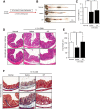Substance-P Ameliorates Dextran Sodium Sulfate-Induced Intestinal Damage by Preserving Tissue Barrier Function
- PMID: 30603535
- PMCID: PMC6171643
- DOI: 10.1007/s13770-017-0085-7
Substance-P Ameliorates Dextran Sodium Sulfate-Induced Intestinal Damage by Preserving Tissue Barrier Function
Abstract
Intestinal inflammation alters immune responses in the mucosa and destroys colon architecture, leading to serious diseases such as inflammatory bowel disease. Thus, the modulation of intestinal integrity and immune responses in IBD can be the critical factor to be considered to reduce the severity of damages. Substance-P (SP), endogenous peptide to be involved in cell proliferation, migration and immune modulation, can exert the therapeutic effect on diverse diseases including cornea damage, rheumatoid arthritis and diabetic complications. SP was found to elevate expression of junctional molecule. Considering the function of SP reported previously, it was inferred that SP is capable of exert the beneficial effect of SP on intestinal diseases by controlling intestinal structure as well as immune responses. In this study, we explored the therapeutic effect of SP on dextran sodium sulfate-induced intestine damage by injecting SP. The effects of SP were evaluated by analyzing crypt structures, proliferating cell pool and infiltration of immune cells. DSS treatment provoked abnormal immune response and disruption of intestine epithelial barrier. However, co-treatment of SP obviously blocked the development of intestinal damages by declining inflammatory responses and sustaining intestinal structure more intact. The treatment of SP to chronic damages also promoted intestinal regeneration by preserving the integrity of colon tissue. Moreover, DSS-induced reduction of epithelial junctional molecule was obviously inhibited by SP treatment in vitro. Taken together, our data indicate that SP can reduce intestinal damages, possibly by modulating barrier structure and immune response. Our results propose SP as candidate therapeutics in intestinal damages.
Keywords: Inflammatory bowel disease; Intestine; Substance-P; Tight junction.
Conflict of interest statement
The authors have no conflict of interest to report.All animal studies were approved by the Ethical Committees for Experimental Animals at Kyung Hee University (Approval number KHMC-IACUC-14-010).
Figures






Similar articles
-
Substance-P alleviates dextran sulfate sodium-induced intestinal damage by suppressing inflammation through enrichment of M2 macrophages and regulatory T cells.Cytokine. 2017 Feb;90:21-30. doi: 10.1016/j.cyto.2016.10.002. Epub 2016 Oct 14. Cytokine. 2017. PMID: 27750083
-
R-spondin1, a novel intestinotrophic mitogen, ameliorates experimental colitis in mice.Gastroenterology. 2007 Apr;132(4):1331-43. doi: 10.1053/j.gastro.2007.02.001. Epub 2007 Feb 6. Gastroenterology. 2007. PMID: 17408649
-
Fermented barley and soybean (BS) mixture enhances intestinal barrier function in dextran sulfate sodium (DSS)-induced colitis mouse model.BMC Complement Altern Med. 2016 Dec 3;16(1):498. doi: 10.1186/s12906-016-1479-0. BMC Complement Altern Med. 2016. PMID: 27912750 Free PMC article.
-
Effect of toll-like receptor 3 agonist poly I:C on intestinal mucosa and epithelial barrier function in mouse models of acute colitis.World J Gastroenterol. 2017 Feb 14;23(6):999-1009. doi: 10.3748/wjg.v23.i6.999. World J Gastroenterol. 2017. PMID: 28246473 Free PMC article.
-
Calcium/Ask1/MKK7/JNK2/c-Src signalling cascade mediates disruption of intestinal epithelial tight junctions by dextran sulfate sodium.Biochem J. 2015 Feb 1;465(3):503-15. doi: 10.1042/BJ20140450. Biochem J. 2015. PMID: 25377781 Free PMC article.
Cited by
-
Transient Receptor Potential Channels and Inflammatory Bowel Disease.Front Immunol. 2020 Feb 20;11:180. doi: 10.3389/fimmu.2020.00180. eCollection 2020. Front Immunol. 2020. PMID: 32153564 Free PMC article. Review.
-
Neurokinin receptors and their implications in various autoimmune diseases.Curr Res Immunol. 2021 Jul 1;2:66-78. doi: 10.1016/j.crimmu.2021.06.001. eCollection 2021. Curr Res Immunol. 2021. PMID: 35492389 Free PMC article. Review.
-
Guardians of the gut: influence of the enteric nervous system on the intestinal epithelial barrier.Front Med (Lausanne). 2023 Aug 25;10:1228938. doi: 10.3389/fmed.2023.1228938. eCollection 2023. Front Med (Lausanne). 2023. PMID: 37692784 Free PMC article. Review.
-
Gut neuropeptide involvement in Parkinson's disease.Am J Physiol Gastrointest Liver Physiol. 2025 Jun 1;328(6):G716-G733. doi: 10.1152/ajpgi.00383.2024. Epub 2025 Apr 25. Am J Physiol Gastrointest Liver Physiol. 2025. PMID: 40279198 Free PMC article. Review.
-
Dioscin ameliorates slow transit constipation in mice by up-regulation of the BMP2 secreted by muscularis macrophages.Iran J Basic Med Sci. 2022 Sep;25(9):1132-1140. doi: 10.22038/IJBMS.2022.64683.14236. Iran J Basic Med Sci. 2022. PMID: 36246057 Free PMC article.
References
LinkOut - more resources
Full Text Sources
